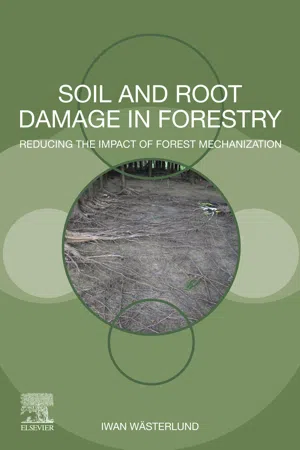
Soil and Root Damage in Forestry
Reducing the Impact of Forest Mechanization
- 200 pages
- English
- ePUB (mobile friendly)
- Available on iOS & Android
About this book
Agroforestry has significantly impacted our forests, but an often-overlooked issue is the effect of harvesting on soils and root systems. Soil and Root Damage in Forestry explains how soil and roots might be damaged through logging activities or silvicultural activities, how resulting root diseases impact the root and soil systems, and the impacts of chemical applications on the soil and root system. This book goes beyond the 'why' to also provide methods to reduce the impacts of machines on soils and offers solutions to minimize the impacts of machines on soils. Soil and Root Damage in Forestry serves as a valuable resource not only for those already working in soil science and forest ecology, but also provides insights for advanced students seeking an entrance to the "hidden half" of the planet.- Combines damages to soil and roots in one volume for the first time- Includes calculations related to soil strength providing soil scientists and ecologists with methods to estimate root damage- Provides suggestions on how to reduce the impact of harvesting on soil and root systems
Frequently asked questions
- Essential is ideal for learners and professionals who enjoy exploring a wide range of subjects. Access the Essential Library with 800,000+ trusted titles and best-sellers across business, personal growth, and the humanities. Includes unlimited reading time and Standard Read Aloud voice.
- Complete: Perfect for advanced learners and researchers needing full, unrestricted access. Unlock 1.4M+ books across hundreds of subjects, including academic and specialized titles. The Complete Plan also includes advanced features like Premium Read Aloud and Research Assistant.
Please note we cannot support devices running on iOS 13 and Android 7 or earlier. Learn more about using the app.
Information
Chapter 1: Forest responses to soil disturbance due to machine traffic
Abstract
Kewwords
Introduction

After Adams, P.W., Froehlich, H.A., 1981. Compaction of Forest Soils. Oregon State University, Extension Service, PNW-217.
Clearfelling operations
Trafficated area
Table of contents
- Cover image
- Title page
- Table of Contents
- Copyright
- Dedication
- Preface
- Chapter 1. Forest responses to soil disturbance due to machine traffic
- Chapter 2. Impacts of soil disturbance on forest and forest soils
- Chapter 3. Impeded root growth in compacted till soils
- Chapter 4. Soil and root strength
- Chapter 5. Rutting on peaty soil
- Chapter 6. Soil mechanics for forestry ground and measurements
- Chapter 7. Alpine routes reinforced with geonet for ATV
- Chapter 8. Logging residues as soil–root protection
- Index